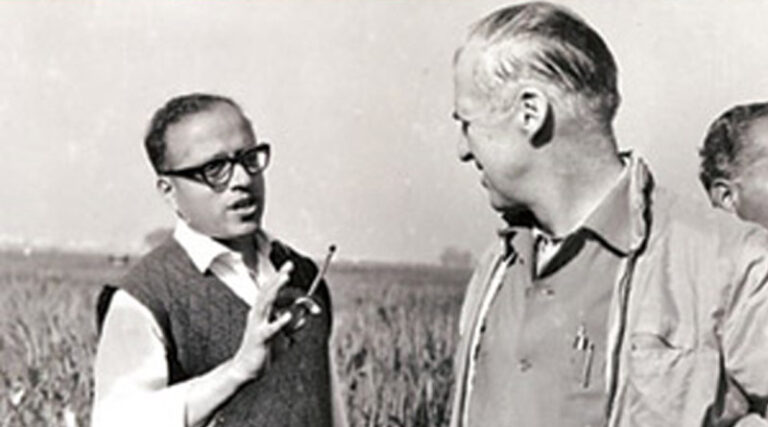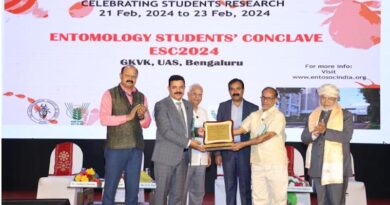
The Legacy of a Visionary: Celebrating 100 Years of Prof. M. S. Swaminathan
04 August 2025, New Delhi: In the annals of modern Indian history, few individuals have left an imprint as deep and transformative as Prof. Mankombu Sambasivan Swaminathan. Born on 7 August 1925, Prof. Swaminathan is revered as the architect of India’s Green Revolution — a scientific and policy movement that changed the destiny of a nation struggling with food insecurity and famine in the 1960s. As the world marks his 100th birth anniversary in 2025, India is once again reminded of the vision, resolve, and science-driven foresight that reshaped its agricultural narrative.

This centenary is more than a celebration of one man’s achievements. It is a national reflection on the transformation of Indian agriculture — from the specter of mass hunger to becoming one of the largest food producers globally. It is also a moment of pride as the country records its highest-ever foodgrain output in 2024–25, touching 3539.59 Lakh Metric Tonnes (LMT), according to the Third Advance Estimates released by the Ministry of Agriculture and Farmers’ Welfare.
A Nation on the Brink: The Pre-Green Revolution Era
To fully appreciate the scale of Prof. Swaminathan’s contribution, one must revisit India’s agrarian state in the decades following independence. In 1950, India’s population was close to 350 million, and its foodgrain production hovered around 50 million tonnes. Wheat production was approximately 12 million tonnes, and rice yields were low, averaging around 0.8 tonnes per hectare. Rain-fed farming, traditional seed varieties, and a heavy dependence on monsoons made Indian agriculture vulnerable and unproductive.
The 1950s and early 1960s were marked by recurring food shortages, rising dependence on food imports under programs like PL-480 from the United States, and a national policy that was reactive rather than proactive. Cereal production growth averaged a modest 2.4% per annum, barely matching the population growth rate, and failing to build food reserves. Famines were a feared reality, with the Bengal famine of 1943 still fresh in national memory. Agricultural productivity was stagnant, rural poverty was rampant, and the country faced the real possibility of a food crisis turning into a humanitarian disaster.
A Revolution Begins: The Green Revolution and Prof. Swaminathan’s Role
The turning point came in the mid-1960s. With the country’s food security at risk, Prime Minister Lal Bahadur Shastri called for radical reforms. This was when Dr. M. S. Swaminathan, then working at the Indian Agricultural Research Institute (IARI), began collaborating with international scientists like Dr. Norman Borlaug. Swaminathan played a crucial role in adapting Borlaug’s Mexican semi-dwarf wheat varieties to Indian conditions. His foresight led to the widespread introduction of high-yielding varieties (HYVs), improved irrigation methods, fertilizer use, and institutional support.
Under his leadership, India adopted these technologies initially in Punjab, Haryana, and western Uttar Pradesh, which had better irrigation facilities and agro-climatic suitability. By 1968, India witnessed an unprecedented jump in wheat production—from 12 million tonnes in 1965 to over 20 million tonnes in just five years. The rise in production was not limited to wheat. Over time, high-yielding rice varieties such as IR8 and IR20 also became widespread, boosting rice output and helping the country attain self-sufficiency.
In a few short years, India went from being a food-deficient nation relying on imports to one with overflowing granaries. The Green Revolution laid the foundation for India’s food security and, more importantly, for the dignity and independence of Indian agriculture.
Quantifying the Transformation: Foodgrain Production from 1965 to Today
The data tells a powerful story. At the onset of the Green Revolution in 1965–66, India’s total foodgrain production was approximately 72.4 million tonnes. Of this, wheat accounted for just about 12 million tonnes. By 1980, the total foodgrain output had more than doubled to over 130 million tonnes, and wheat alone had surged to around 35 million tonnes. Between 1966 and 1990, the annual growth rate in wheat production stood at over 5%, and rice production also saw sustained increases.
Punjab, the epicenter of the Green Revolution, saw its wheat production grow from less than 1 million tonnes in 1960 to over 10 million tonnes by the mid-1980s. Rice production in the state, which was negligible in the 1950s, crossed 5 million tonnes by 1990, making Punjab the country’s leading contributor to the central food grain pool.
Fast forward to 2024–25, and the transformation is staggering. The Third Advance Estimates released by the Ministry of Agriculture peg India’s total foodgrain production at a record 3539.59 LMT (353.95 million tonnes). This is an increase of 216.61 LMT (21.66 million tonnes) over the previous year’s production of 3322.98 LMT, registering a growth rate of approximately 6.5% year-on-year. Such figures are a testament not just to agricultural policy and innovation, but also to the legacy of a movement that Prof. Swaminathan ignited six decades ago.
Beyond Quantities: A Vision Rooted in Sustainability and Equity
While Prof. Swaminathan is globally recognized for ushering in the Green Revolution, his contributions go far beyond productivity gains. He coined the term “Evergreen Revolution” — a call to make agricultural growth sustainable, equitable, and environmentally responsible. He warned early on about the ecological costs of overusing chemical fertilizers, water-intensive crops, and mono-cropping systems. He advocated for crop diversification, preservation of indigenous seed varieties, gender-inclusive farming, and the integration of biotechnology and traditional wisdom.
He was also a key voice in policies such as the Minimum Support Price (MSP) system, Land Reforms, and the creation of research institutions focused on farmers’ needs. In later years, through the M. S. Swaminathan Research Foundation (MSSRF), he championed coastal agriculture, climate change adaptation, and food security in tribal and ecologically sensitive regions.
Celebrating His Legacy: 100th Birth Anniversary Initiatives
In 2025, India is commemorating the centenary of Prof. Swaminathan with the reverence that his legacy demands. The Government of India released a ₹100 commemorative coin in his honour, minted in Kolkata and carrying his likeness. The state of Maharashtra has declared 7 August as “Sustainable Agriculture Day,” with educational institutions being encouraged to start ‘Bio-happiness Centres’ in his name to promote sustainable farming practices, biodiversity conservation, and eco-friendly innovation.
Academic lectures, awards, and rural campaigns are being organized by institutions like the Indian Council of Agricultural Research (ICAR), MSSRF, and the Indian National Science Academy (INSA) to engage young scientists and farmers alike in the Swaminathan legacy.
Looking Ahead: The Future of Indian Agriculture
As India celebrates Prof. Swaminathan’s centenary with the record-breaking foodgrain production of 2024–25 as a backdrop, it stands at a crossroads. The foundation he laid has carried the nation from scarcity to self-sufficiency. But the new century presents fresh challenges—climate variability, shrinking farm sizes, groundwater depletion, and the nutrition gap.
Prof. Swaminathan always emphasized that the success of agriculture must not be measured merely in tonnes but in the ability to nourish people, sustain ecosystems, and empower rural communities. His clarion call for a “nutrition-sensitive, climate-resilient, and economically viable” farming model remains more relevant today than ever.
A Century of Impact, and Beyond
The Green Revolution turned India into a food-secure nation. But it was the vision, courage, and scientific grounding of Prof. M. S. Swaminathan that gave it life. On his 100th birth anniversary, the nation not only salutes a giant of Indian science but also recommits to the principles he stood for — science with a human face, growth with equity, and innovation with sustainability.
As we enter a new chapter in agricultural advancement, with technology, precision farming, and genomics shaping the future, it is only fitting that we walk in the path that Prof. Swaminathan laid — rooted in compassion, guided by evidence, and driven by a singular goal: food and dignity for all.
Also Read: New Holland’s Intellisense Is Changing The Baling Game
📢 If You’re in Agriculture, Make Sure the Right People Hear Your Story.
From product launches to strategic announcements, Global Agriculture offers unmatched visibility across international agri-business markets. Connect with us at pr@global-agriculture.com to explore editorial and advertising opportunities that reach the right audience, worldwide.






